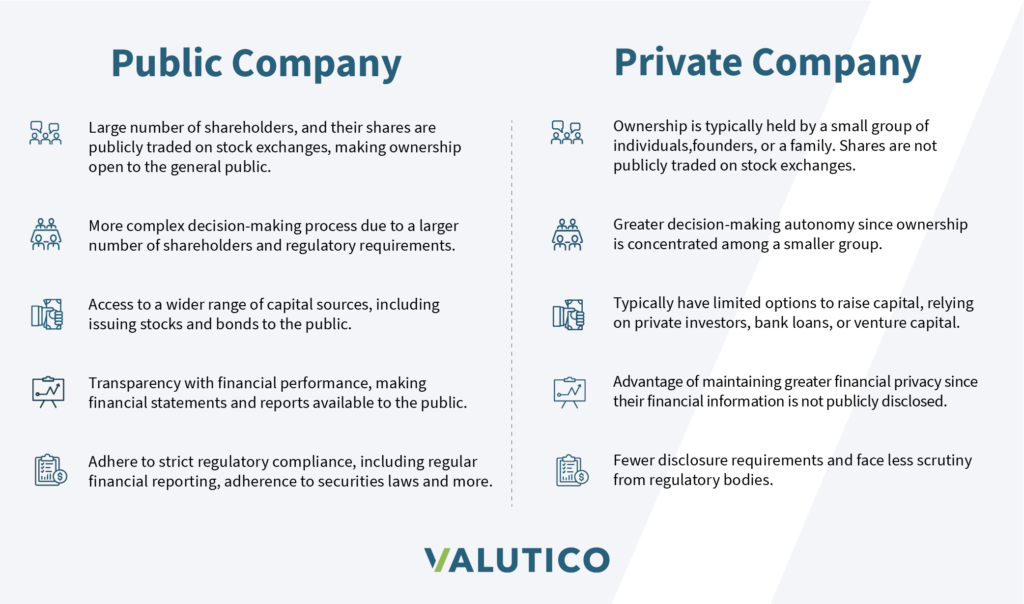Private Company Valuations—A Complete Guide

In this article, we’ll explore private company valuations, including methods, considerations, and challenges. We’ll start by examining the differences between private and public companies and their impact on valuation.
What is a private company valuation? Private company valuation refers to the process of determining the value of a privately-held company. Unlike public companies that have readily available market prices, valuing private companies requires assessing various factors to estimate their worth. A common way to value a private company is by using the Discounted Cash Flow (DCF) or a Comparable Company Analysis (CCA), and by taking into account factors such as financial performance, growth prospects, industry dynamics, and risk factors.
Key Takeaways:
- Private companies have a smaller group of owners and are not publicly traded, while public companies have numerous shareholders and trade on stock exchanges.
- Common methods to value private companies include the Discounted Cash Flow (DCF) and the Comparable Company Analysis (CCA).
- Factors influencing private company valuations include financial performance, industry and market conditions, growth prospects, intellectual property, and customer base.
- Challenges in private company valuations include limited transparency, illiquid shares, influence of controlling shareholders, and subjective assumptions.
- In the DCF method, the value of the business is calculated by estimating the future cash flows of the business, with a discount rate applied.
- In the CCA method, valuation multiples such as P/E ratio, EV/Revenue ratio, and EV/EBITDA ratio, provide benchmarks for estimating value by comparing financial metrics to publicly traded companies.
What is a Private Company Valuation?
Private company valuation is the process of determining the economic value or worth of a privately held company, taking into account factors such as financial performance, growth prospects, industry dynamics, and risk factors.
How Do You Value a Private Company? The Short Answer
In short, a highly basic method to value a private company is to use an industry ‘multiple’. There are several multiples you can use such as EV/Sales, or EV/EBITDA. In a quick example of one of the simplest ways to value a business (although not necessarily accurate), you might do the following:
The construction supplies industry might have an EV/Sales multiple of 2.15. So you could take the sales of your construction business for the last year and times by 2.15.
However, this is a ‘back of the envelope’ calculation and not something that should be used in a professional context. Instead, a valuation professional would usually conduct a Discounted Cash Flow analysis whereby you project future cash flows, and then discount by a certain amount. The DCF is widely considered a leading method to value a private company. Another complimentary method is to conduct a Comparable Company Analysis (CCA), which is a more thorough version of the multiple approach just described, wherein instead of relying on a high-level ‘industry’ multiple, you combine multiples from several companies that are similar to the one you are valuing.
How Do Professionals Value a Private Company?
As mentioned above, the leading methods include the DCF and the CCA, which are sometimes used in combination to provide a valuation range. There are some challenges when valuing companies using these methods that professionals learn to overcome. In particular, the DCF projections of future cash flow must be accurate or the valuation will not reflect a fair picture. In a CCA, the peer companies that are selected must be appropriately similar to the company being valued.
In addition, there are a range of different methods for different specialist use cases that professionals employ depending on the company they are valuing. One example is the Venture Capital valuation method which is sometimes used to value startups.
In some cases, professionals will use tools or software to assist in their valuations, such as Valutico valuation software.
Private Vs. Public Company
Private and public companies differ in several ways. Private companies have a smaller group of owners, and benefit from increased decision-making autonomy, confidentiality, and flexibility. In contrast, public companies, have a larger number of shareholders, are obligated to adhere to stringent regulations but gain the advantage of accessing robust capital markets. The choice between maintaining a private status or going public hinges on a company’s objectives and financial situation.

Difference Between Private and Public Company Valuation
The main difference between private company valuation and public company valuation lies in the availability of information and market dynamics. Public companies have readily available financial data, trade on public exchanges, and are subject to market forces.
In contrast, private companies have limited disclosure requirements, lack liquidity in their shares, and rely more on fundamental analysis. Valuing private companies requires gathering information from various sources and employing different approaches to estimate their worth, considering factors specific to the company and its industry.
Private Company Valuation Formulas
Valuing a private company involves using various valuation methods and approaches. While there is no one-size-fits-all formula, several commonly used methods can provide a foundation for the valuation process.
Here are four key valuation methods frequently employed in private company valuations:
Discounted Cash Flow (DCF) Analysis:
DCF analysis estimates the present value of a company’s future cash flows. The formula involves three key steps:
a) Projecting Future Cash Flows: The valuation starts by projecting the company’s expected cash flows over a specific period. These cash flows typically include operating income, tax payments, and changes in working capital and capital expenditures.
b) Determining the Discount Rate: The discount rate, often the weighted average cost of capital (WACC), reflects the risk associated with the company’s cash flows. It considers the company’s cost of equity, cost of debt, and capital structure.
c) Calculating Present Value: The projected cash flows are then discounted to their present value using the discount rate. The present values of all projected cash flows are summed to determine the company’s intrinsic value.
For example:
Let’s compare the valuation of a private car company and a well-known publicly traded car company like Tesla. Suppose the private car company projects annual cash flows of $5 million for the next five years, applying a discount rate of 12%. The discounted cash flow (DCF) analysis indicates an estimated intrinsic value of $16.65 million for the private car company.
In contrast, Tesla, being a publicly traded company, generates annual cash flows of $1 billion for the same five-year period, with a discount rate of 12%. Applying the DCF analysis to Tesla’s cash flows yields an estimated intrinsic value of $3.56 billion.
The valuation comparison between the private car company and Tesla highlights a significant disparity due to factors such as scale, brand recognition, market share, and growth potential. This discrepancy underscores the influence of market perception, industry dynamics, and investor sentiment on the valuation of publicly traded companies like Tesla compared to private car companies. When valuing private companies, it is essential to account for their distinct characteristics, industry position, growth prospects, and risk factors to arrive at a reasonable estimate of intrinsic value.
Asset-Based Approaches:
Asset-based approaches determine a company’s value based on its net asset value (NAV). Two commonly used asset-based approaches are:
a) Book Value Method:
The book value method calculates a company’s net asset value by subtracting total liabilities from the fair market value of total assets. While this approach focuses on the balance sheet, it may not consider intangible assets or future earnings potential.
b) Liquidation Value Method:
The liquidation value method estimates the value of a company’s assets in a liquidation scenario, considering the fair market value of sellable assets like equipment, inventory, and real estate. This approach assumes the company will cease operations.
Asset-based approaches can provide a floor value for a private company, especially when its tangible assets are significant compared to its earnings potential.
Comparable Company Analysis:
Comparable company analysis compares the financial metrics, ratios, and valuation multiples of the target private company to similar companies. It uses the market values and financial performance of comparable companies to estimate the target company’s valuation range.
The key steps in performing a comparable company analysis are:
a) Identifying Comparable Companies: Finding companies that are similar to the private company in terms of industry, size, growth prospects, and risk profile.
b) Gathering Financial Data: Collecting financial information, such as revenue, earnings, and valuation multiples, for the comparable companies.
c) Analyzing Valuation Metrics: Comparing the valuation multiples, such as P/E ratio or EV/EBITDA ratio, of the comparable companies to estimate a valuation range for the private company.
For example:
For a private technology company, applying the average price-to-earnings (P/E) ratio of 20x to its earnings of $10 million would yield an estimated valuation of $200 million based on comparable company analysis.
In contrast, using the average P/E ratio of 30x for Apple and its earnings of $50 billion would result in an estimated valuation of $1.5 trillion.
This example highlights the valuation disparity between the private technology company and Apple using comparable company analysis, showcasing the influence of market perception, investor sentiment, and company scale on public and private company valuations.
Book a free demo with Valutico to access comparable company information and data.
Challenges in Private Company Valuations
Valuing private companies presents its own set of unique challenges that require careful navigation. Unlike their publicly traded counterparts, private companies face limited transparency and availability of financial information, which can complicate the valuation process. Here are some key challenges to consider:
Lack of market data:
Private companies operate outside the realm of public markets, where pricing and valuation data are readily available. The absence of comparable transactions and market indicators can make it challenging to determine an accurate valuation. However, by booking a free demo with Valutico, you can gain exclusive access to the essential market data you need.
Limited financial disclosure:
Private companies’ limited obligation to publicly disclose financial information leads to a lack of comprehensive data for analysis. Investors and valuation professionals often rely on limited financial statements, which may not offer a complete picture of the company’s performance.
Subjectivity in assumptions:
Valuing private companies often involves making assumptions about future performance, growth prospects, and market conditions. These assumptions can be subjective and vary among different stakeholders, leading to divergent valuations.
Illiquidity and lack of exit options:
Private company shares are typically illiquid and not easily traded on public exchanges. The absence of a liquid market can impact the valuation process and make it more challenging for investors to determine an appropriate value.
Influence of controlling shareholders:
In many private companies, a single or a few controlling shareholders hold significant influence over the company’s operations and decision-making. This concentrated ownership can introduce complexities in assessing the fair value of minority stakes.
Valuation professionals use various methods, including discounted cash flow analysis, comparable company analysis, and qualitative assessments, to understand the company, industry, and market conditions, and arrive at a reasonable valuation.
Factors Influencing Private Company Valuation
Valuing a private company requires assessing various factors beyond financial metrics, considering its operations, industry landscape, and prospects. Key factors in private company valuation include:
Financial Performance:
The financial performance of a private company is crucial for its valuation. Assessing revenue growth, profitability, and cash flow generation through historical statements and projections determines its ability to sustain earnings.
Industry and Market Conditions:
The industry in which the private company operates, and the overall market conditions can affect its valuation. Factors such as market growth potential, competitive landscape, and barriers to entry are considered to evaluate the company’s position within its industry.
Growth Prospects:
The growth potential of a private company is key to its valuation. Factors like innovation, market expansion, and business scalability are assessed to gauge future revenue and earnings potential.
Intellectual Property and Assets:
Intellectual property, proprietary technology, patents, and other valuable assets owned by the private company can contribute to its valuation. These assets can provide a competitive advantage and create barriers to entry for potential competitors.
Customer Base and Relationships:
Customer base factors impact a private company’s value. Considerations include size, loyalty, diversification, long-term relationships, recurring revenue, and a robust sales pipeline.
Risk Factors:
Evaluating risks is vital in valuing a private company. Factors like regulatory compliance, market volatility, operational risks, and dependence on key customers or suppliers are considered to assess the company’s risk profile.
Comparable Transactions:
Analyzing comparable transactions in the industry can provide valuable insights into the valuation of a private company. Examining recent mergers, acquisitions, or financing rounds involving similar companies can help establish a benchmark for valuation multiples. You can access these valuation multiples by booking a free demo with Valutico.
Private Company Valuation Multiples
When it comes to private company valuation multiples, several key multiples are commonly used as benchmarks for estimating value. These multiples compare specific financial metrics to those of comparable publicly traded companies. While accessing private company data for accurate multiples can be challenging due to limited disclosure, innovative solutions like Valutico offer a valuable resource. Book your demo to access private company multiples.
Valutico offers access to a comprehensive database of private company financials and industry data, enabling accurate estimation of valuation multiples. Users can analyze private company financial statements, growth metrics, and industry benchmarks for a precise assessment of valuation multiples.
Price-to-Earnings (P/E) Ratio:
The P/E ratio compares a company’s stock price to its Earnings Per Share (EPS). It is calculated by dividing the market price per share by the EPS. The P/E ratio reflects how much investors are willing to pay for each dollar of earnings generated by the company.
For example:
In a comparison between Microsoft and the private company XYZ Software:
For Microsoft:
P/E Ratio = Stock Price of Microsoft / Earnings per Share (EPS) of Microsoft
For the private company XYZ Software:
P/E Ratio = Estimated Stock Price of XYZ Software / Earnings per Share (EPS) of XYZ Software
Microsoft has a P/E ratio of approximately 42.86, indicating that investors are willing to pay around $42.86 for every $1 of earnings generated by the company. On the other hand, XYZ Software has an estimated P/E ratio of 15, suggesting that investors are willing to pay about $15 for every $1 of earnings generated by the private company. This difference in P/E ratios reflects variations in investor sentiment and valuation between the public and private companies.
Enterprise Value-to-Revenue (EV/Revenue) Ratio:
The EV/Revenue ratio measures the company’s Enterprise Value (market capitalization plus debt minus cash) relative to its total revenue. It indicates how much value the market assigns to each dollar of the company’s revenue.
For example:
Let’s compare Amazon.com Inc., a public company, with a hypothetical private company in the e-commerce industry. Amazon.com has an Enterprise Value-to-Revenue (EV/Revenue) ratio of approximately 5, indicating the market values it at around 5 times its total revenue. For the private company, XYZ E-commerce, the estimated EV/Revenue ratio is also 5, suggesting a similar valuation based on revenue generation.
This example demonstrates how the market values both the public and private companies at a multiple of their total revenue.
Enterprise Value-to-EBITDA (EV/EBITDA) Ratio:
The EV/EBITDA ratio compares the company’s enterprise value to its Earnings before Interest, Taxes, Depreciation, and Amortization (EBITDA). It provides a measure of the company’s value relative to its EBITDA, which represents its operating profitability.
For example:
Let’s compare Google (Alphabet Inc.), a public company, with a hypothetical private company in the technology industry. Google has an Enterprise Value-to-EBITDA (EV/EBITDA) ratio of 20, indicating that the market values it at 20 times its EBITDA. For the private company, XYZ Tech, the estimated EV/EBITDA ratio is also 20, suggesting a similar valuation based on operating profitability.
This example highlights how the market values both the public and private companies at a multiple of their EBITDA.
Price-to-Sales (P/S) Ratio:
The P/S ratio compares the company’s stock price to its total sales or revenue. It is calculated by dividing the market capitalization by the company’s total revenue. The P/S ratio reflects how much investors are willing to pay for each dollar of the company’s sales.
By incorporating access to private company multiples through platforms like Valutico, valuation professionals and investors can make more informed decisions and gain deeper insights into the relative valuation of private companies within their respective industries.
For example:
In comparing Facebook Inc. and a hypothetical private company in the social media industry, both have a P/S ratio of 10, indicating similar valuations based on sales performance. This demonstrates how the market values both public and private companies by considering a multiple of their total sales.
This example highlights how the market assesses the value of both public and private companies by considering a multiple of their total sales.
In Summary
Valuing private companies is complex due to limited financial information and unique characteristics. This article explores differences between private and public companies, challenges in private company valuations, key factors influencing valuation, methods like discounted cash flow and comparable company analysis, and valuation multiples. By considering these aspects and using reliable resources, investors can navigate complexities and make informed decisions.
To access superior data and comprehensive analysis for private company valuation, book a demo with Valutico specialists. Their valuation software offers tailored demonstrations, showcasing the extensive range of data and insights that can meet your specific business requirements.





